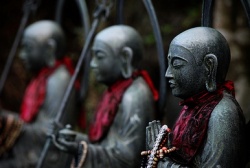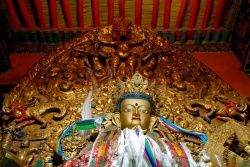Mahayana and tantric mystical doctrines
The situation takes on a different complexion in Mahayana and Tantra Tantric Buddhism. Here one encounters the notion of the Buddhas as kinds of cosmic wizards or magicians, as the creators of, and rulers over, “Buddha fields” (Buddha Paradises – whole world systems of spiritual exaltation and instruction). Although there are countless Buddhas, their essence is one - that of "Tathata" ("suchness" or "that-ness") - , and it is in this sense that the Buddha proclaims himself as "Tathagata" and exalts himself in theistic terms beyond all other "gods" when he declares: "I am the god above the gods, superior to all the gods; no god is like me - how could there be a higher?" (Lalitavistara Sutra). There are also many examples in the Pali Canon, where the Buddha shows his magical superiority over the Brahma class of gods. So this was already present in the Pa?li scriptures/ agamas. His realm (“dhatu”), of which he is the "Holy King" (Nirvana Sutra), is further said to inhere in all beings. This indwelling, indestructible, incomprehensible, divine sphere or essence is called the “Buddha-dhatu” (Buddha-sphere, Buddha-nature, Buddha-realm) or “Tathagatagarbha” in such sutras as the “Mahaparinirvana Sutra” and the “Anunatva-Apurnatva-Nirdesa”.
Further, the idea of an eternal, all-pervading, all-knowing, immaculate, uncreated and deathless Ground of Being (the dharmadhatu, inherently linked to the sattvadhatu, the realm of beings), which is the Awakened Mind (bodhicitta) or Dharmakaya (“body of Truth”) of the Buddha himself, is promulgated in such texts. In the Mahavairocana Sutra, this essence of the one ultimate Buddha, named Vairocana, is symbolised by the letter “A”, which is said to reside in the hearts of all beings and of which Buddha Vairocana declares: “[the mystic letter ‘A’] is placed in the heart location: it is Lord and Master of all, and it pervades entirely all the animate and inanimate. ‘A’ is the highest life-energy …” (The Maha-Vairocana-Abhisambodhi Tantra, p. 331). This great Vairocana Buddha is called: “the Bhagavat [ = Blessed One - a term traditionally linked in Indian discourse with "the Divine"], Master of the Dharma, the Sage who is completely perfect, who is all-pervasive, who encompasses all world systems, who is All-Knowing, the Lord Vairocana” (p. 355). The Tantra Tantric text, The Sarva-Tathagata-Tattva-Samgraha, eulogises the supreme Buddha Vairocana in the following theistic paeons: “He is universal Goodness, beneficial, destroyer [of suffering), the great Lord of Happiness, sky womb, Great Luminosity … the great All-perceiving Lord … He is without beginning or end … [He is] Vishnu (God) … Protector of the world, the sky, the earth … The elements, the good benefactor of beings, All things … the Blessed Rest, Eternal … The Self of all the Buddhas … Pre-eminent over all, and master of the world.”
Similar God-like descriptions are encountered in the All-Creating King Tantra, where the universal Mind of Awakening (personified as “Samantabhadra Buddha” - the “All-Good”) declares of himself: “I am the core of all that exists. I am the seed of all that exists. I am the cause of all that exists. I am the trunk of all that exists. I am the foundation of all that exists. I am the root of existence. I am ‘the core’ because I contain all phenomena. I am ‘the seed’ because I give birth to everything. I am ‘the cause’ because all comes from me. I am ‘the trunk’ because the ramifications of every event sprout from me. I am ‘the foundation’ because all abides in me. I am called ‘the root’ because I am everything.” (The Supreme Source, p. 157). Thus Buddhism spans a grand arch from evident non-theism to mystically hued mentalist pantheism. There is also in Mahayana Buddhism, the concept of an ADI-BUDDHA.
This being is the primordial, self-existent, self-created Buddha who some believe that the whole of creation stems from. Some Mahayana devotees of a certain bodhisattva may also elevate this enlightened being to the status of godhood or deity as a mark of devotion. For example, the Japanese buddha Amida of the Pure Land school of Buddhism is a popular choice of deity. Adherents of this system believe that a certain chant of faith intoned daily will result in devotees of Amida at death entering Jodo (the Pure Land), a beautiful paradise peopled by angels and lesser buddhas singing next to lakes of ambrosia and sweet, sweet flowers. The awesome beauty of this heavenly paradise is beyond description and the souls of the dead may remain there as long as they wish until they are ready to reincarnate again. Pure Land Buddhism is a very popular form of the religion in Japan. Another elevated bodhissatva is the Tibetan goddess Tara who embodies compassion and wisdom and is said to to be the queen of all buddhas. Her powers of intercession are said to be unlimited and a thousand arms on her devotional statues reach out in all directions to aid and protect her followers from all harm.

